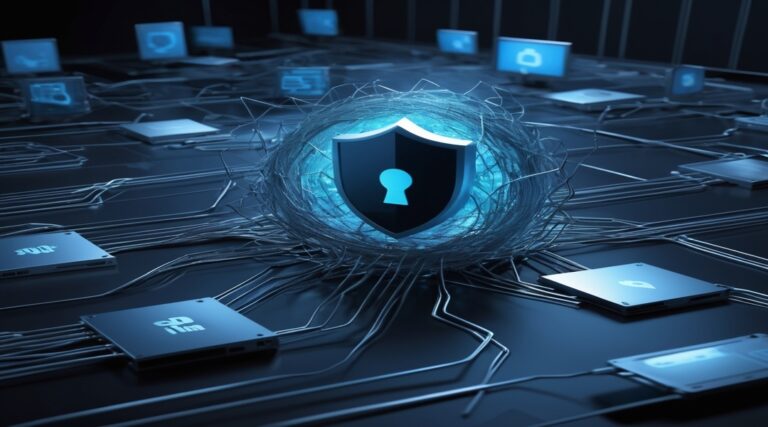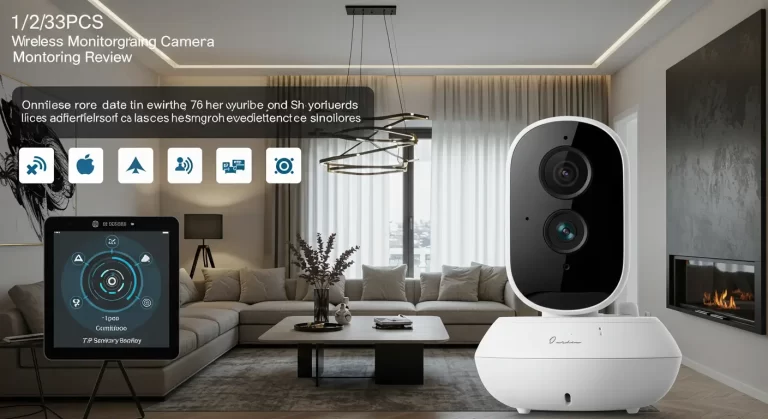Network Security: 8 Ways to Safeguard Your Business
In today’s hyperconnected digital landscape, network security is no longer optional—it’s essential for business survival. Every 39 seconds, a hacker attack occurs somewhere in the world, with 43% of these attacks targeting small businesses. The consequences? Devastating data breaches, operational disruptions, and financial losses that average $4.35 million per incident according to IBM’s 2024 Cost of a Data Breach Report.
The digital threat landscape continues to evolve at an alarming pace. Ransomware attacks grew by 300% in the last year, while sophisticated phishing schemes and zero-day exploits leave even established enterprises vulnerable. The statistics paint a clear picture: no organization—regardless of size or industry—can afford to ignore network security.
The good news? With proper network security measures in place, your business can significantly reduce these risks. By implementing comprehensive protection strategies, you’re not just defending against attacks—you’re building customer trust, ensuring business continuity, and creating a foundation for sustainable growth in the digital economy. Let’s explore how you can transform your network from a vulnerability into one of your strongest business assets.
Table of Contents
What is Network Security?
Network security encompasses all the technologies, policies, and practices designed to protect your digital infrastructure from unauthorized access, misuse, or attacks. Think of it as the digital equivalent of a sophisticated security system for your physical office—complete with locks, alarms, security guards, and surveillance cameras.
At its core, network security creates a fortified perimeter around your valuable digital assets, preventing malicious actors from accessing sensitive information while allowing legitimate users to work efficiently. It involves multiple layers of defense, from hardware and software solutions to protocols and user education.
Network security isn’t just about installing a firewall and forgetting it—it’s an ongoing process that requires vigilance, updates, and adaptation as new threats emerge. Ready to discover how to build an impenetrable digital fortress for your business? Let’s dive deeper.
Why You Need Network Security
1. Protection Against Cyber Threats
Today’s cyber threats are more sophisticated and damaging than ever before. Malware can silently infiltrate your systems, corrupting files and stealing data. Phishing attacks trick employees into revealing sensitive information or downloading malicious software. DDoS attacks can overwhelm your servers, bringing operations to a complete standstill.
In 2023 alone, ransomware attacks cost businesses an estimated $20 billion in damages, with the average downtime following an attack lasting 21 days. Without robust network security, your organization becomes an easy target for cybercriminals looking for vulnerabilities to exploit. Consider the 2021 Colonial Pipeline attack, which resulted in fuel shortages across the Eastern United States—a stark reminder that cyber threats can have real-world consequences.
2. Financial and Data Security Benefits
Investing in network security isn’t just about preventing attacks—it’s about protecting your bottom line. The average cost of a data breach continues to rise yearly, including direct costs like ransom payments and recovery expenses, as well as indirect costs like reputation damage and customer loss.
Strong network security protects your most valuable assets: proprietary information, customer data, financial records, and intellectual property. When this data falls into the wrong hands, the consequences can be catastrophic. Equifax’s 2017 data breach exposed the personal information of 147 million people and cost the company over $1.7 billion in settlements and security upgrades.
3. Compliance with Security Regulations
Regulatory compliance isn’t optional in today’s business environment. Depending on your industry and location, you must adhere to various data protection regulations:
- GDPR in Europe requires strict data protection measures with penalties reaching €20 million or 4% of global annual revenue
- HIPAA mandates specific safeguards for healthcare data, with violations costing up to $1.5 million per year
- PCI DSS compliance is essential for businesses handling credit card information
- CCPA and other state-level regulations impose additional requirements for US businesses
Robust network security doesn’t just protect against attacks—it ensures you meet these regulatory requirements, avoiding costly fines and legal complications while building customer trust.
How to Implement Network Security
Quick Overview
A comprehensive network security strategy combines multiple defensive layers working together to protect your digital assets. At minimum, this includes properly configured firewalls, strong encryption for data (both in transit and at rest), and rigorous authentication protocols to verify user identities.
Effective implementation requires regular software updates to patch vulnerabilities, continuous monitoring to detect suspicious activities, and ongoing employee training to prevent social engineering attacks. Remember that network security is never “finished”—it’s an ongoing process that evolves with your business and the threat landscape.
Key Components of Network Security
1. Firewalls
Firewalls serve as your network’s first line of defense, filtering traffic based on predetermined security rules. They analyze incoming and outgoing packets, blocking potentially malicious traffic while allowing legitimate communications. Modern next-generation firewalls (NGFWs) offer advanced features like deep packet inspection, application awareness, and integrated intrusion prevention.
2. Intrusion Detection and Prevention Systems (IDPS)
While firewalls filter traffic based on predefined rules, IDPS solutions actively monitor for suspicious activities that might indicate an attack in progress. Detection systems alert security teams to potential threats, while prevention systems can automatically block malicious traffic. These tools use signature-based detection, anomaly detection, and behavioral analysis to identify threats that bypass other security measures.
3. Virtual Private Networks (VPNs)
VPNs create encrypted tunnels for secure communication over public networks. They’re essential for remote work, allowing employees to safely access company resources from any location. By encrypting data in transit, VPNs prevent eavesdropping and man-in-the-middle attacks, ensuring sensitive information remains confidential even when using unsecured Wi-Fi networks.
4. Endpoint Security Solutions
With the proliferation of devices connecting to corporate networks, endpoint security has become critical. These solutions protect individual devices (computers, smartphones, IoT devices) from threats through antivirus software, application control, and device encryption. Modern endpoint protection platforms (EPPs) use AI and behavioral analysis to detect and neutralize advanced threats before they spread across your network.
5. Multi-Factor Authentication (MFA)
Passwords alone are no longer sufficient for secure access. MFA requires additional verification factors—something you know (password), something you have (security token), or something you are (biometrics)—significantly reducing the risk of unauthorized access even if credentials are compromised. Studies show MFA can block up to 99.9% of automated attacks.
6. Data Encryption
Encryption transforms readable data into coded text that can only be deciphered with the correct encryption key. It protects data both in transit (moving across networks) and at rest (stored on servers or devices). Strong encryption ensures that even if attackers gain access to your data, they cannot read or use it without the encryption keys.
7. Security Information and Event Management (SIEM)
SIEM systems collect and analyze security event data from across your network, providing real-time visibility into potential threats and security incidents. By correlating data from multiple sources, SIEM solutions help security teams identify attack patterns, respond to incidents faster, and maintain compliance with security policies and regulations.
8. Regular Security Audits and Penetration Testing
Proactive security testing identifies vulnerabilities before attackers can exploit them. Regular security audits assess your overall security posture, while penetration testing simulates real-world attacks to test your defenses. These assessments highlight security gaps and provide actionable recommendations for strengthening your network security.
Step-by-Step Guide to Strengthening Network Security
1. Conduct a Comprehensive Risk Assessment
Begin by identifying your critical assets and potential vulnerabilities:
- Inventory all hardware, software, and data assets
- Document your current security controls
- Identify potential threats and vulnerabilities
- Assess the impact of potential breaches
- Prioritize risks based on likelihood and potential damage
2. Implement Layered Security Defenses
Build multiple security layers to protect your network:
- Configure perimeter firewalls to filter traffic based on your security policy
- Install internal firewalls to segment your network
- Deploy IDPS solutions to monitor for suspicious activities
- Implement VPNs for secure remote access
- Secure all endpoints with appropriate protection software
3. Establish Strong Access Controls
Control who can access your systems and data:
- Implement the principle of least privilege (users have minimum access needed)
- Deploy multi-factor authentication for all accounts
- Create strong password policies (complexity, regular changes, no reuse)
- Regularly audit user accounts and remove unnecessary access
- Use privileged access management for administrative accounts
4. Secure Your Data
Protect your most valuable asset—your data:
- Classify data based on sensitivity
- Implement appropriate encryption for each data type
- Develop and enforce data handling policies
- Regularly back up critical data (following the 3-2-1 rule)
- Test data recovery procedures regularly
5. Monitor and Maintain Your Security
Security is an ongoing process:
- Deploy SIEM solutions for centralized monitoring
- Establish incident response procedures
- Regularly update and patch all systems
- Conduct periodic security assessments and penetration tests
- Stay informed about emerging threats
6. Train Your Employees
Your team is both your greatest vulnerability and your first line of defense:
- Conduct regular security awareness training
- Teach employees to recognize phishing attempts
- Establish clear security policies and procedures
- Run simulated phishing exercises
- Create a security-conscious culture
What to Combine Network Security With
For maximum protection, integrate network security with these complementary measures:
Cloud Security Solutions
As businesses migrate to cloud environments, traditional network boundaries dissolve. Cloud security solutions extend your security policies to cloud resources, providing visibility and control over cloud-based assets. These include Cloud Access Security Brokers (CASBs), Cloud Workload Protection Platforms (CWPPs), and Cloud Security Posture Management (CSPM) tools.
Zero Trust Architecture
The traditional “trust but verify” approach is obsolete in today’s complex environments. Zero Trust assumes that threats exist both outside and inside the network, requiring verification for everyone and everything attempting to connect to your systems. This architecture combines strict identity verification, microsegmentation, and least privilege access to minimize your attack surface.
AI-Powered Threat Detection
Artificial intelligence and machine learning enhance security by analyzing vast amounts of data to identify patterns and anomalies that might indicate attacks. These technologies detect sophisticated threats that traditional signature-based methods might miss, allowing for faster response to emerging attack vectors.
Cyber Hygiene Training
Technical controls are only part of the equation—human error remains a significant vulnerability. Comprehensive training programs transform employees from security liabilities into security assets. Regular cyber hygiene training, simulated phishing exercises, and clear security policies help create a security-first mindset throughout your organization.
Top Tips for Strengthening Network Security
1. Implement Defense in Depth
Don’t rely on a single security solution. Layer multiple controls to ensure that if one fails, others will still protect your assets.
2. Automate Security Where Possible
Use automation to handle routine security tasks like patch management, vulnerability scanning, and security monitoring. This reduces human error and allows your team to focus on strategic security initiatives.
3. Segment Your Network
Divide your network into isolated segments to contain breaches and minimize damage. Critical systems and sensitive data should reside in highly secured network segments with strict access controls.
4. Adopt a Security-First Development Approach
Integrate security into your development process from the beginning. Security is much more effective (and less expensive) when built into systems rather than added afterward.
5. Regularly Test Your Security
Conduct regular penetration tests and red team exercises to identify vulnerabilities before attackers do. These tests provide valuable insights into your security posture and highlight areas for improvement.
6. Create an Incident Response Plan
Prepare for security incidents before they happen. A well-documented incident response plan enables your team to react quickly and effectively when breaches occur, minimizing damage and recovery time.
7. Stay Informed About Emerging Threats
The threat landscape evolves constantly. Subscribe to threat intelligence feeds, participate in industry security groups, and maintain relationships with security professionals to stay informed about new threats and vulnerabilities.
8. Storing and Managing Security Logs
Comprehensive logging is essential for effective security monitoring and incident response. Maintain logs of all security events, network traffic, and system activities, storing them securely for future analysis. Implement log management solutions that aggregate and correlate events across your environment, highlighting potential security incidents for investigation. SIEM systems automate much of this process, providing real-time alerts and facilitating faster response to security incidents.
Frequently Asked Questions
What is a good firewall for small business?
For small businesses, unified threat management (UTM) firewalls like Fortinet FortiGate, SonicWall TZ series, or Cisco Meraki MX offer comprehensive protection with simplified management. These solutions combine traditional firewall capabilities with additional security features like intrusion prevention, antivirus, and content filtering in a single appliance, providing robust protection without requiring extensive IT resources.
How does network information security differ from cybersecurity?
Network information security focuses specifically on protecting network infrastructure and the data transmitted across it, while cybersecurity encompasses a broader range of digital security measures. Think of network information security as a crucial subset of the larger cybersecurity discipline, focusing on network-specific threats, protocols, and defenses rather than application security, endpoint protection, or security governance.
What should I look for when evaluating network security companies?
When selecting network security companies, prioritize those with industry certifications (like ISO 27001), proven experience in your specific industry, comprehensive service offerings (including managed services and incident response), and a track record of staying current with emerging threats. Request case studies, speak with existing clients, and ensure their services align with your specific security requirements and compliance needs.
How often should you perform network penetration testing?
Network penetration testing should be conducted at least annually, but more frequently when: implementing significant network changes, deploying new applications or systems, after major infrastructure updates, or when industry regulations require it. Many compliance frameworks (like PCI DSS) mandate regular penetration testing, and organizations with high-value assets or in high-risk industries should consider quarterly testing.
What are the key elements of effective network security monitoring?
Effective network security monitoring combines real-time threat detection, comprehensive log collection, behavioral analysis, and automated alerting systems. Critical components include network traffic analysis tools, SIEM systems that correlate events across multiple sources, endpoint detection and response (EDR) solutions, and clearly defined escalation procedures to ensure proper response to identified threats.
How do I choose between different network security providers?
Select network security providers based on your specific business requirements, evaluating their expertise in your industry, service level agreements, response capabilities, and integration with your existing infrastructure. Consider their approach to emerging threats, managed service offerings, compliance expertise, and whether they function as a strategic partner rather than just a vendor. Request detailed proposals addressing your specific security challenges.
What network security solutions work best for cloud environments?
Cloud-specific network security solutions include Cloud Access Security Brokers (CASBs), Cloud Workload Protection Platforms (CWPPs), and Cloud Security Posture Management (CSPM) tools. When moving to cloud environments, implement cloud-native security tools designed for your specific cloud provider(s), maintain visibility across multi-cloud environments, and ensure consistent security policies across hybrid infrastructures.
How does cloud security network architecture differ from traditional approaches?
Cloud security network architecture embraces a perimeter-less approach, focusing on data and identity protection rather than network boundaries. Unlike traditional network security that relies heavily on perimeter defenses, cloud security networks implement microsegmentation, zero trust principles, identity and access management controls, and API-driven security. This architecture accommodates dynamic scaling, distributed resources, and shared responsibility models unique to cloud environments.
What’s the relationship between cyber security and network security?
Cyber security encompasses all aspects of digital security including network security, application security, endpoint protection, security governance, and user education. Network security is a fundamental component of cybersecurity, focusing specifically on protecting network infrastructure, connections, and transmitted data. A comprehensive cybersecurity strategy must include strong network security, while network security alone is insufficient for complete digital protection.







